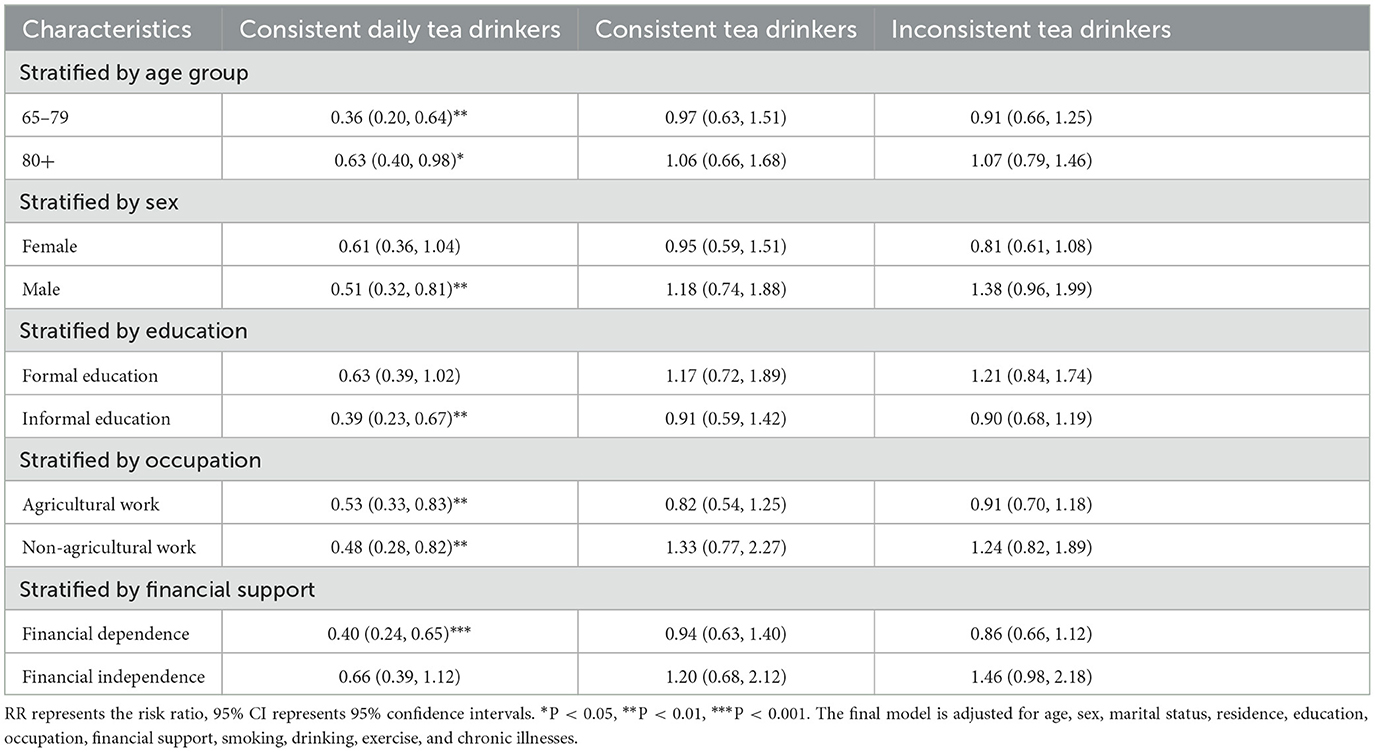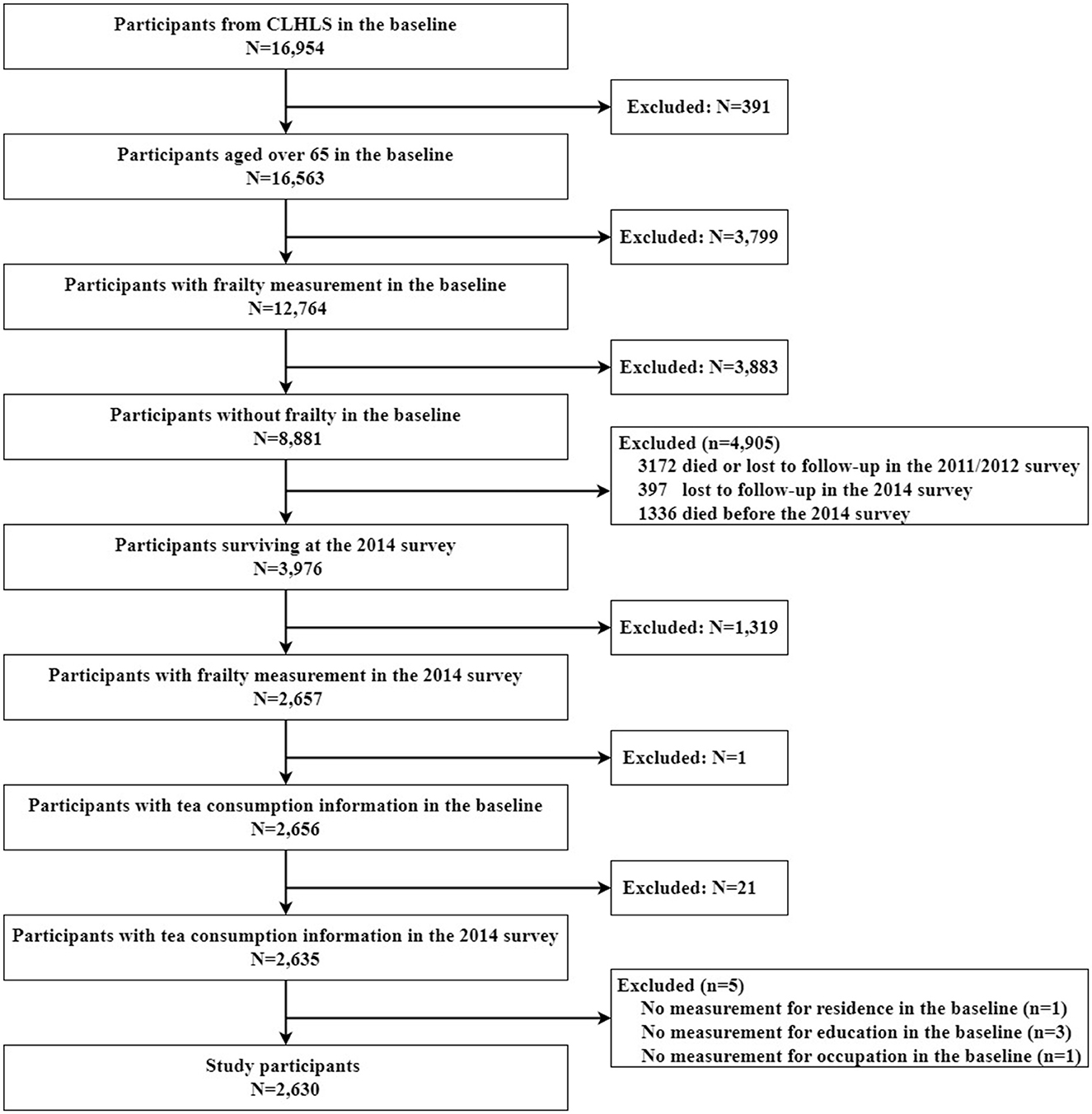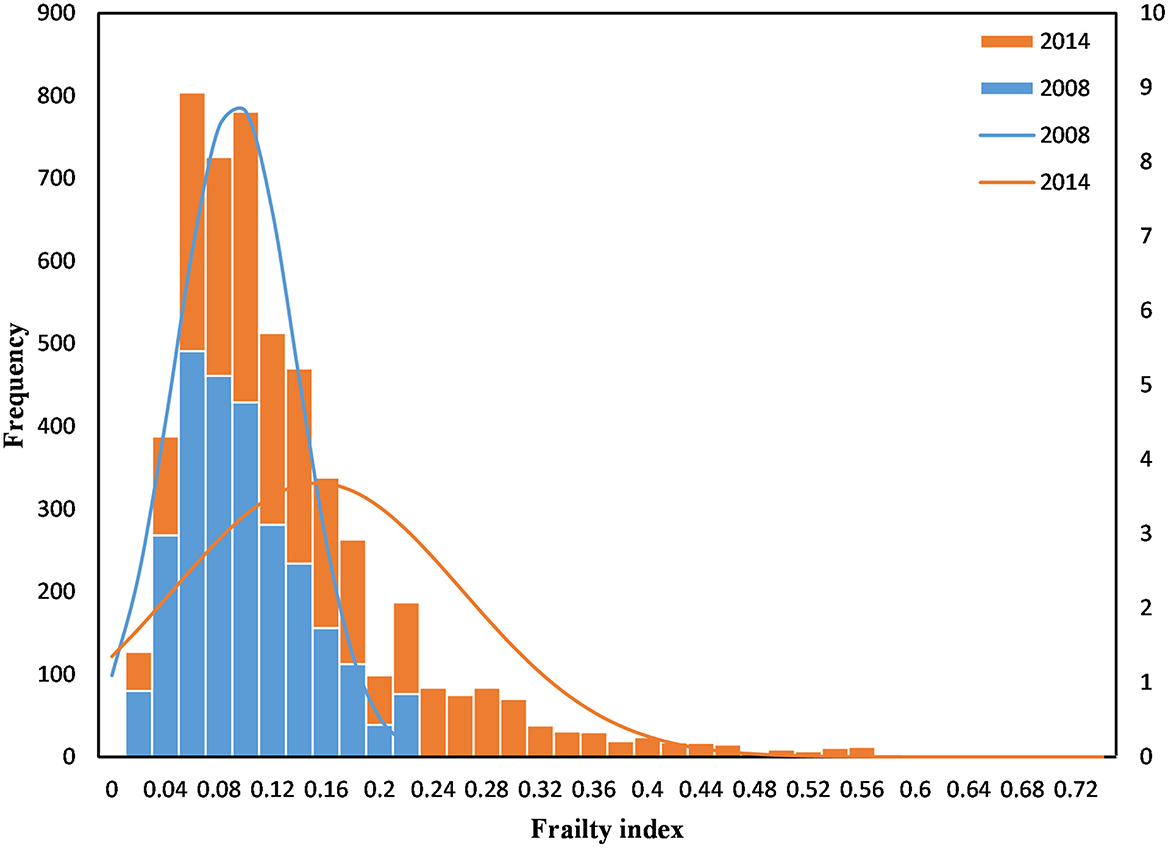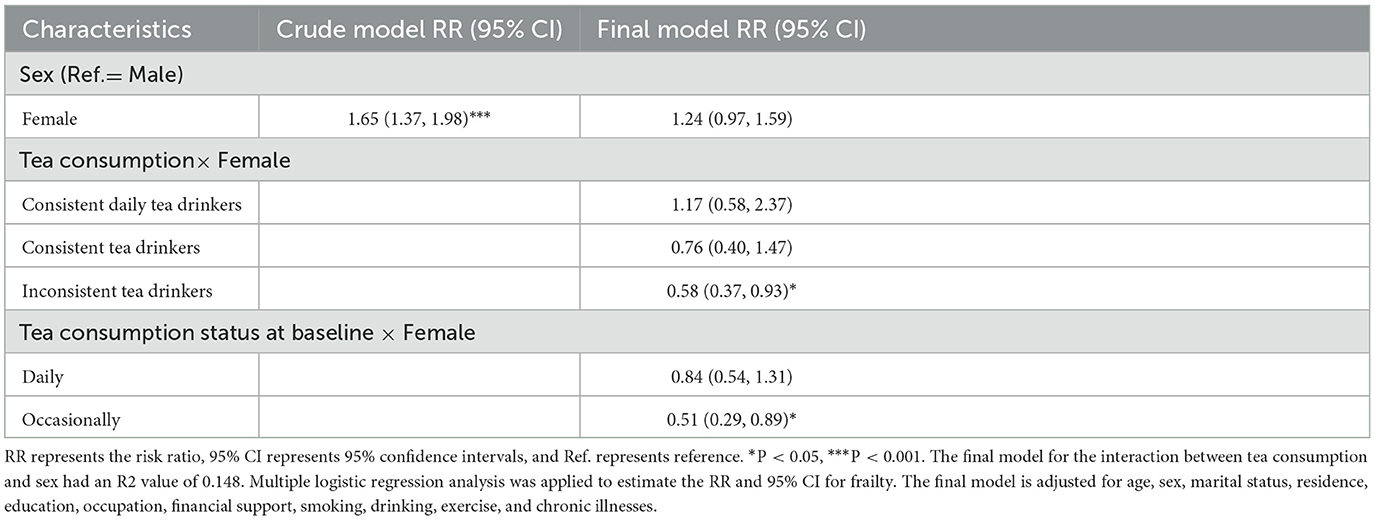- 1School of Public Health, Bengbu Medical College, Bengbu, China
- 2School of Health Management, Bengbu Medical College, Bengbu, China
A corrigendum on
Long-term tea consumption reduces the risk of frailty in older Chinese people: Result from a 6-year longitudinal study
by Gao, T., Han, S., Mo, G., Sun, Q., Zhang, M., and Liu, H. (2022). Front. Nutr. 9:916791. doi: 10.3389/fnut.2022.916791
In the published article, there was an error in Figures 1, 2, Tables 1–4 and text as published. We erroneously regarded the variable of tea drinking before age 60 as the variable of a current tea drinking to select the sample and analysis the data. We also that we excluded covariate according to the 2008 baseline survey, but 2008 was erroneously written as 2014 in Figure 1. The present final sample size was 2,473, and the corrected sample size was 2,630. The corrected Figures 1, 2, Tables 1–4 and corrected text appear below.

Table 1. Characteristics of older adults by tea consumption, tea consumption status in 2008 baseline, and frailty in the 2014 follow-up.

Table 3. The association between tea consumption and frailty stratified by age, sex, and socioeconomic status.
A correction has been made to the Section Abstract, subsection “Methods.” This sentence previously stated:
“Two thousand four hundred and seventy three participants completed six-follow-up surveys in 2014 and were analyzed in this study.”
The corrected sentence appears below:
“Two thousand six hundred and thirty participants completed six-follow-up surveys in 2014 and were analyzed in this study. ”
A correction has been made to the Section Abstract, subsection “Results.” These sentences previously stated:
“Of the 2,473 participants, 14.1% were consistent daily tea drinkers, and 22.6% reported frailty at the 6-year follow-up. Compared to non-tea drinkers, consistent daily tea drinkers reported a significantly lower ratio of having frailty [risk ratio (RR) = 0.54, 95% confidence interval (CI): 0.38–0.78], adjusting for sociodemographic characteristics, health behavior, socioeconomic status, and chronic illnesses. In further subgroup analyses, consistent daily tea consumption significantly reduced the risk of frailty for males (RR = 0.53, 95% CI: 0.32–0.87) but not females (RR = 0.65, 95% CI: 0.37–1.12); in the young (RR = 0.40, 95% CI: 0.22–0.74) but not in the oldest (aged ≥ 80) (RR = 0.66, 95% CI: 0.40–1.06); informal education (RR = 0.48, 95% CI: 0.28–0.84) but not formal education (RR = 0.62, 95% CI: 0.37–1.03); financial dependence (RR = 0.42, 95% CI: 0.25–0.71) but not financial independence (RR = 0.71, 95% CI: 0.41–1.23).”
The corrected sentences appear below:
“Of the 2,630 participants, 15.3% were consistent daily tea drinkers, and 22.6% reported frailty at the 6-year follow-up. Compared to non-tea drinkers, consistent daily tea drinkers reported a significantly lower ratio of having frailty [risk ratio (RR) = 0.51, 95% confidence interval (CI): 0.36–0.71], adjusting for sociodemographic characteristics, health behavior, socioeconomic status, and chronic illnesses. In further subgroup analyses, consistent daily tea consumption significantly reduced the risk of frailty for males (RR = 0.51, 95% CI: 0.32–0.81) but not females (RR = 0.61, 95% CI: 0.36–1.04); informal education (RR = 0.39, 95% CI: 0.23–0.67) but not formal education (RR = 0.63, 95% CI: 0.39–1.02); financial dependence (RR = 0.40, 95% CI: 0.24–0.65) but not financial independence (RR = 0.66, 95% CI: 0.39–1.12). Tea consumption was associated with a lower risk of frailty in both the young (RR = 0.36, 95% CI: 0.20–0.64) and the oldest (aged ≥ 80) (RR = 0.63, 95% CI: 0.40–0.98).”
A correction has been made to the Section Materials and methods, subsection “Study sample,” paragraph 2. This sentence previously stated:
“Finally, 2,473 participants completed a six-follow-up survey in 2014 and were analyzed in this study.”
The corrected sentence appears below:
“Finally, 2,630 participants completed a six-follow-up survey in 2014 and were analyzed in this study.”
A correction has been made to the Section Materials and methods, subsection “Definition of frailty,” paragraph 1. This sentence previously stated:
“The scale of a frailty index in this study has a Cronbach's alpha of 0.867.”
The corrected sentence appears below:
“The scale of a frailty index in this study has a Cronbach's alpha of 0.870.”
A correction has been made to the Section Materials and methods, subsection “Definition of frailty,” paragraph 1. This sentence previously stated:
“The participants with a score of >0.21 were referred to as frail (32), while those with a score of <0.21 were referred to as not frail.”
The corrected sentence appears below:
“The participants with a score of >0.21 were referred to as frail (32), while those with a score of ≤0.21 were referred to as not frail.”
Corrections have been made to the Section Results, paragraphs 1, 2, 3 and 4. These sentences previously stated:
“Characteristics of the participants at baseline are summarized in Table 1. The sample was composed of 2,473 participants, with 1,251 males (50.6%) and 1,222 females (49.4%). The participants' mean age was 76.88 (SD = 8.5) years. Of these participants, 63.4% were aged 65–79 years, and 36.6% were aged ≥ 80 years; 56.1% were married, 89.1% resided in rural areas, 50.5% had informal education, 68.4% did agricultural work, 58.1% were financially dependent on others, and 51.7% had chronic illnesses.”
“Table 1 summarizes the characteristics of respondents by the types of tea drinkers and tea consumption status at baseline of CLHLS. Of the 2,473 participants, 35.8% were non-tea drinkers, 38.8% were inconsistent tea drinkers, 11.2% were consistent tea drinkers, and 14.1% were consistent daily tea drinkers. Categorized by tea drinking status at baseline, 48.2% were non-tea drinkers, 15.6% were occasional tea drinkers, and 36.2% were daily tea drinkers.”
“Table 1 also shows the association of participants' characteristics with frailty. The mean frailty index for participants was 0.15 (SD = 0.11) (Figure 2). The prevalence of frailty was 22.6% among older people, higher in the ≥ 80 years group (37.0%) than in the 65–79 years group (14.3%). Older people with frailty were likely to be female, have another marital status, have informal education, not smoke, not drink, be financially dependent on others, and have chronic illnesses. There was no significant difference in residence (P = 0.156), occupation (P = 0.381), and exercise (P = 0.392).”
“Compared to non-tea drinkers, consistent daily tea drinkers had a significantly lower ratio of frailty (RR = 0.47, 95% CI: 0.33–0.66) in the crude and (RR = 0.54, 95% CI: 0.38–0.78) adjusted models (Table 2). However, daily tea drinkers had a lower ratio of frailty (RR = 0.75, 95% CI: 0.60–0.92) in the crude model, but the difference became small and not statistically significant (RR = 0.81, 95% CI: 0.65–1.02) in the adjusted final model. Additionally, we investigated whether tea benefits differ by age, sex, and socioeconomic status. As shown in Table 3, consistent daily tea consumption resulted in a significantly reduced risk of frailty in males (RR = 0.53, 95% CI: 0.32–0.87) but not in females (RR = 0.65, 95% CI: 0.37–1.12); in the young (RR = 0.40, 95% CI: 0.22–0.74) but not in the oldest (aged ≥ 80) (RR = 0.66, 95% CI: 0.40–1.06); in informal education (RR = 0.48, 95% CI: 0.28–0.84) but not in formal education (RR = 0.62, 95% CI: 0.37–1.03); in financial dependence (RR = 0.42, 95% CI: 0.25–0.71) but not in financial independence (RR = 0.71, 95% CI: 0.41–1.23). Tea consumption was associated with a lower risk of frailty in both agricultural work (RR = 0.61, 95% CI: 0.38–0.97) and non-agricultural work (RR = 0.46, 95% CI: 0.25–0.82).”
The corrected sentences appear below:
“Characteristics of the participants at baseline are summarized in Table 1. The sample was composed of 2,630 participants, with 1,353 males (51.4%) and 1,277 females (48.6%). The participants' mean age was 76.84 (SD = 8.5) years. Of these participants, 63.5% were aged 65–79 years, and 36.5% were aged ≥ 80 years; 56.8% were married, 89.1% resided in rural areas, 49.8% had informal education, 68.1% did agricultural work, 57.9% were financially dependent on others, and 51.7% had chronic illnesses.”
“Table 1 summarizes the characteristics of respondents by the types of tea drinkers and tea consumption status at baseline of CLHLS. Of the 2,630 participants, 35.6% were non-tea drinkers, 36.5% were inconsistent tea drinkers, 12.6% were consistent tea drinkers, and 15.3% were consistent daily tea drinkers. Categorized by tea drinking status at baseline, 45.3% were non-tea drinkers, 16.0% were occasional tea drinkers, and 38.7% were daily tea drinkers.”
“Table 1 also shows the association of participants' characteristics with frailty. The mean frailty index for participants was 0.15 (SD = 0.11) (Figure 2). The prevalence of frailty was 22.6% among older people, higher in the ≥ 80 years group (37.2%) than in the 65–79 years group (14.2%). Older people with frailty were likely to be female, have another marital status, have informal education, not smoke, not drink, be financially dependent on others, and have chronic illnesses. There was no significant difference in residence (P = 0.214), occupation (P = 0.232), and exercise (P = 0.565).”
“Compared to non-tea drinkers, consistent daily tea drinkers had a significantly lower ratio of frailty (RR = 0.34, 95% CI: 0.29–0.39) in the crude and (RR = 0.51, 95% CI: 0.36–0.71) adjusted models (Table 2). However, daily tea drinkers had a lower ratio of frailty (RR = 0.78, 95% CI: 0.64–0.96) in the crude model, but the difference became small and not statistically significant (RR = 0.86, 95% CI: 0.69–1.07) in the adjusted final model. Additionally, we investigated whether tea benefits differ by age, sex, and socioeconomic status. As shown in Table 3, consistent daily tea consumption resulted in a significantly reduced risk of frailty in males (RR = 0.51, 95% CI: 0.32–0.81) but not in females (RR = 0.61, 95% CI: 0.36–1.04); in informal education (RR = 0.39, 95% CI: 0.23–0.67) but not in formal education (RR = 0.63, 95% CI: 0.39–1.02); in financial dependence (RR = 0.40, 95% CI: 0.24–0.65) but not in financial independence (RR = 0.66, 95% CI: 0.39–1.12). Tea consumption was associated with a lower risk of frailty in both the young (RR = 0.36, 95% CI: 0.20–0.64) and the oldest (aged ≥ 80) (RR = 0.63, 95% CI: 0.40–0.98); agricultural work (RR = 0.53, 95% CI: 0.33–0.83) and non-agricultural work (RR = 0.48, 95% CI: 0.28–0.82).”
The authors apologize for these errors and state that these do not change the scientific conclusions of the article in any way. The original article has been updated.
Publisher's note
All claims expressed in this article are solely those of the authors and do not necessarily represent those of their affiliated organizations, or those of the publisher, the editors and the reviewers. Any product that may be evaluated in this article, or claim that may be made by its manufacturer, is not guaranteed or endorsed by the publisher.
Keywords: tea consumption, frailty, China, older people, CLHLS
Citation: Gao T, Han S, Mo G, Sun Q, Zhang M and Liu H (2023) Corrigendum: Long-term tea consumption reduces the risk of frailty in older Chinese people: Result from a 6-year longitudinal study. Front. Nutr. 10:1153726. doi: 10.3389/fnut.2023.1153726
Received: 30 January 2023; Accepted: 21 February 2023;
Published: 07 March 2023.
Approved by:
Frontiers Editorial Office, Frontiers Media SA, SwitzerlandCopyright © 2023 Gao, Han, Mo, Sun, Zhang and Liu. This is an open-access article distributed under the terms of the Creative Commons Attribution License (CC BY). The use, distribution or reproduction in other forums is permitted, provided the original author(s) and the copyright owner(s) are credited and that the original publication in this journal is cited, in accordance with accepted academic practice. No use, distribution or reproduction is permitted which does not comply with these terms.
*Correspondence: Huaqing Liu, bGhxYmJtY0AxNjMuY29t; Min Zhang, em1iYm1jQDE2My5jb20=
 Tianjing Gao
Tianjing Gao Siyue Han
Siyue Han Guangju Mo
Guangju Mo Qing Sun
Qing Sun Min Zhang
Min Zhang Huaqing Liu
Huaqing Liu


